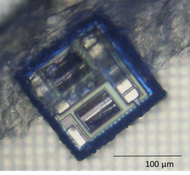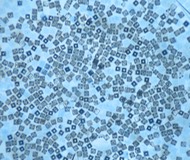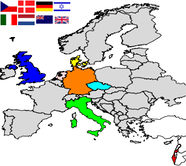Strategies for achieving movement of the lablets were focused on two physical mechanisms: (1) magnetotaxis, whereby an external magnetic field was used for controlling the positioning of the lablets, and (2) chemotaxis, whereby the ability of oil droplets to migrate in salt concentration gradients was utilised. In both cases, the most challenging practical problem was that of buoyancy. The material composition of the lablets means that their density is approximately 3000 kg/m3, which means they sink in water (density 1000 kg/m3). Once the lablets sink, frictional force with the bottom of the vessel containing the lablets is too high to be overcome by forces that can be generated by known laboratory chemotactic mechanisms. Therefore, before any form of taxis could be investigated, the density problem had to be solved.
The chosen approach was based on using a “balloon” to lift the lablet, i.e. to attach a droplet of an organic (oil) phase whose density is lower than that of water, and choosing the volume of the droplet so that the combined density of the lablet-droplet pair is comparable to that of water. After a search for suitable oil phase and suitable methods for attaching the droplet to the lablet and then separating the attached lablet from other droplets that do not contain any lablets, a method was found. This method was based on using an oil-based ferrofluid, i.e. a dispersion of hydrophobic iron oxide nanoparticles in the oil phase, and then using an external magnetic field to manipulate with the droplets. In this case, a 200 µm droplet is sufficient to achieve combined density of 945 kg/m3.
Once the buoyancy was achieved and the lablets could freely move in aqueous environment, their manipulation by an external magnetic field was realised. Lablets were placed into rectangular pools or channels made of PDMS using moulds formed by a 3D printer and positioned between four electromagnets under a stereomicroscope connected to a camera and digital signal processing. The position of the lablet was monitored and its motion in the X-Y plane was controlled by adjusting the voltage on the individual electromagnets. A sample “mission” whose objective was to follow a predefined trajectory and eventually position the tablet at a specified location was then demonstrated.
Directed delivery of lablets and chemotaxis of lablets are closely related topics as both involve oriented movement of the lablets. These topics were the subject of a collaborative effort between SDU and VSCHT. Chemotaxis is defined as oriented movement in a concentration gradient. Until the on-board sensing and powering functionality is implemented, lablets cannot rely on self-propelled, oriented motion; however, their chemotaxis can be achieved by coupling lablets to another object that is capable of chemotaxis. In our case, the ability of oil droplets to migrate in salt and pH gradients was investigated. Chemotaxis was achieved as follows: decanol droplet (3, 5 or 10 μl) containing oil red O as colorant was placed by micropipette in a glass-bottom dish containing 600 μl 10mM decanoic acid at pH 11. The salt gradient was formed by adding 10 μl of 5M NaCl containing green or blue food dye as colorant. The maze experiments were performed in the same way, but the maze was filled by 900 μl of decanoic solution.
In summary, the following functionalities were investigated: locomotion of lablets (magnetotaxis and chemotaxis), controlled adhesion and detachment of microparticles and vesicles, electronically controlled accumulation and release of encapsulated payload from vesicles, and physiologically measurable effect of the released payload on cancer cells.




